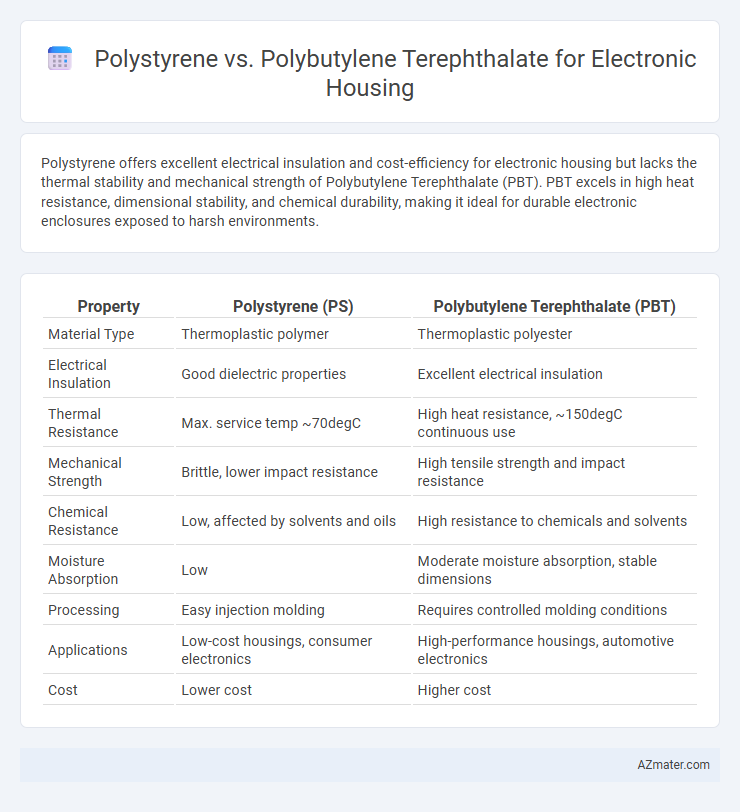Polystyrene offers excellent electrical insulation and cost-efficiency for electronic housing but lacks the thermal stability and mechanical strength of Polybutylene Terephthalate (PBT). PBT excels in high heat resistance, dimensional stability, and chemical durability, making it ideal for durable electronic enclosures exposed to harsh environments.
Table of Comparison
| Property | Polystyrene (PS) | Polybutylene Terephthalate (PBT) |
|---|---|---|
| Material Type | Thermoplastic polymer | Thermoplastic polyester |
| Electrical Insulation | Good dielectric properties | Excellent electrical insulation |
| Thermal Resistance | Max. service temp ~70degC | High heat resistance, ~150degC continuous use |
| Mechanical Strength | Brittle, lower impact resistance | High tensile strength and impact resistance |
| Chemical Resistance | Low, affected by solvents and oils | High resistance to chemicals and solvents |
| Moisture Absorption | Low | Moderate moisture absorption, stable dimensions |
| Processing | Easy injection molding | Requires controlled molding conditions |
| Applications | Low-cost housings, consumer electronics | High-performance housings, automotive electronics |
| Cost | Lower cost | Higher cost |
Introduction to Electronic Housing Materials
Electronic housing materials require a balance of electrical insulation, thermal stability, and mechanical strength to protect sensitive components. Polystyrene offers excellent electrical insulation and ease of molding but falls short in heat resistance and impact strength compared to Polybutylene Terephthalate (PBT). PBT excels with superior thermal stability, chemical resistance, and dimensional rigidity, making it a preferred choice for durable, high-performance electronic housings in demanding environments.
Overview of Polystyrene (PS)
Polystyrene (PS) is a versatile thermoplastic polymer commonly used in electronic housing due to its excellent insulating properties, rigidity, and ease of molding into complex shapes. Its cost-effectiveness and high dimensional stability make it suitable for low-stress applications where impact resistance is not critical. PS offers limited thermal resistance compared to Polybutylene Terephthalate (PBT), making it ideal for electronics with lower operating temperatures but requiring lightweight and precise housing components.
Overview of Polybutylene Terephthalate (PBT)
Polybutylene Terephthalate (PBT) is a thermoplastic polyester known for its excellent electrical insulation, high mechanical strength, and superior chemical resistance, making it ideal for electronic housing applications. Its dimensional stability and low moisture absorption help maintain performance under varying environmental conditions, outperforming many other plastics like polystyrene. PBT's resistance to heat and flame, combined with good surface finish and ease of molding, ensures durable, aesthetically pleasing electronic enclosures with enhanced safety features.
Mechanical Properties Comparison: PS vs PBT
Polybutylene Terephthalate (PBT) offers superior mechanical properties compared to Polystyrene (PS) for electronic housing, including higher impact resistance and better tensile strength, which enhances durability in demanding environments. PBT exhibits excellent dimensional stability and resistance to deformation under mechanical stress, making it suitable for precision electronic components. In contrast, Polystyrene has lower impact resistance and brittleness, limiting its use where mechanical stress and long-term reliability are critical.
Thermal Performance in Electronic Applications
Polystyrene exhibits lower thermal stability and a glass transition temperature around 100degC, making it less suitable for high-heat electronic housing compared to Polybutylene Terephthalate (PBT), which has a thermal resistance up to 150degC and superior dimensional stability at elevated temperatures. PBT's enhanced thermal conductivity and flame retardant properties support better heat dissipation and safety in electronic applications, reducing the risk of component overheating. These thermal performance characteristics make PBT a preferred choice for durable, heat-resistant electronic housings over polystyrene.
Electrical Insulation Capabilities
Polystyrene offers excellent electrical insulation properties due to its high dielectric strength and low moisture absorption, making it suitable for electronic housing applications where insulation reliability is critical. Polybutylene Terephthalate (PBT) exhibits superior dimensional stability and resistance to high temperatures, maintaining consistent electrical insulation performance under thermal stress. PBT's inherent flame retardancy and resistance to chemical degradation provide enhanced protection in harsh electronic environments compared to polystyrene.
Chemical Resistance: PS vs PBT
Polybutylene Terephthalate (PBT) exhibits superior chemical resistance compared to Polystyrene (PS), especially against hydrocarbons, oils, and solvents common in electronic environments. PBT maintains structural integrity and resists degradation when exposed to cleaning agents and moisture, making it highly suitable for electronic housing. Polystyrene, while cost-effective, is susceptible to chemical attack and embrittlement, reducing its durability in harsh chemical conditions.
Processing and Manufacturing Differences
Polystyrene (PS) offers ease of processing due to its low melting point and good flow properties, making it suitable for injection molding electronic housings with intricate designs. Polybutylene Terephthalate (PBT) requires higher processing temperatures and slower cooling rates, benefiting from its semi-crystalline structure to achieve superior dimensional stability and thermal resistance. Manufacturing with PBT often demands more precise mold temperature control and drying procedures to prevent hydrolytic degradation, whereas PS tolerates a more straightforward processing regime.
Cost Analysis and Market Availability
Polystyrene offers a lower cost per unit compared to polybutylene terephthalate (PBT), making it a budget-friendly option for electronic housing manufacturing, especially in high-volume production. However, PBT provides superior thermal stability and chemical resistance, justifying its higher price in applications requiring durability and longevity. Market availability of polystyrene is widespread due to its extensive use across industries, while PBT, although slightly more specialized, has a robust supply chain concentrated among engineering plastic suppliers, catering to electronics manufacturers demanding high-performance materials.
Sustainability and Environmental Impact
Polystyrene, widely used for electronic housing due to its cost-effectiveness and ease of molding, poses significant environmental challenges because it is non-biodegradable and difficult to recycle, contributing to long-term plastic pollution. Polybutylene terephthalate (PBT), a thermoplastic polyester, offers superior sustainability benefits through its recyclability, higher resistance to chemical degradation, and potential for reuse in electronic components, reducing environmental footprint. Choosing PBT over polystyrene supports circular economy principles in electronics manufacturing by minimizing waste and lowering greenhouse gas emissions during production and end-of-life processing.

Infographic: Polystyrene vs Polybutylene Terephthalate for Electronic Housing
 azmater.com
azmater.com